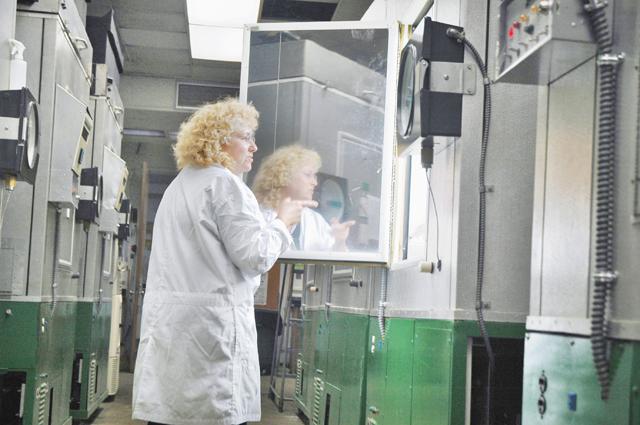If students wanted to grow corn in the winter or simulate a drought in Mexico, they could do it all without leaving Gardner Hall. Gardner houses what is called the Phytotron, one of only a few such facilities of equal size scattered across the country.
Basic set-up
The Phytotron bills itself as a “place for all seasons,” which is the most basic way to sum up its abilities. The building contains growth chambers in three sizes, each of which has a controlled and recorded temperature, day length, humidity, and light intensity, according to Director Carole Saravitz.
The Phytotron’s growth chambers, which are on the ground floor, are different from its greenhouse, which ideally is located the top floor with a glass roof for the best sun exposure. A greenhouse, built out of translucent plastic, relies on sunlight pouring in through its ceiling and walls to grow its plants. A growth chamber is more like a refrigerator, or tightly sealed closet and can replicate any outdoor condition in the world.
Whereas the greenhouse uses sunlight, the chambers use artificial light, which is provided by long rows of fluorescent bulbs, supplemented by scattered incandescent bulbs. One of the most important features of the lighting system is that researchers can adjust how long they stay on simulating the photoperiod, or day length, of any latitude on the planet.
Mirrors line the walls of each chamber to reflect the light back in. Some chambers contain humidifiers or dehumidifiers, depending on whether the research calls for a more wet or dry environment.
For temperature regulation, vents close to the ceiling bring in air, which circulates through to the floor, where it exits. Much like the heat regulation, this motion keeps the environment as uniform as possible.
This is the most fantastic thing about the Phytotron, according to Saravitz: its climate control abilities.
“We can take the same plant starting from a seed and grow it in two different environments, and it will look completely different,” she said. “The way we can manipulate plants to study them [is amazing].”
Research
Field conditions for plant scientists are often varied and hard to record, whereas in the Phytotron, the environment is carefully controlled to maintain consistency.
“We can replicate different controlled environments and seasons,” said Saravitz. “We tailor the environment side to whatever the researcher needs.
Those researchers include scientists from Poland, Japan, Costa Rica and Argentina, as well as graduate students from all over. Within the University alone, students from the College of Agriculture and Life Sciences as well as the departments of forestry, pathology, crop science, biology, genetics and plant biology converge at the Phytotron to conduct valuable research. Saravitz, also on the proposal reviewing committee, said, “We just try to fit in all the projects.”
The research is as varied as the Phytotron’s patronage. “Not everything we have here is pretty,” Saravitz said.
In the growth chambers, everything from cucumber plants, rice, corn, turf grass, peanuts, cotton, to cabbage flourishes at any time of the year.
The more unusual plants include Arabidopsis, a plant grown frequently for study in molecular biology. A few chambers down, Salvinia molesta, an irritating weed responsible for clogging waterways, floats in buckets.
Though dangerous to release into the environment (and requiring written approval to be grown), this plant can be studied safely in the Phytotron, according to Saravitz. Already, researchers are discovering how shade affects Salvinia’s ability to withstand herbicides, an important breakthrough in the fight against this plant’s watery conquests
There is also Artemisia, an Asian plant, which could never grow in Carolinian soil. With the growth chambers and the careful work of researchers to fine tune temperature, photoperiod and growth conditions, this plant is thriving with predictability, Saravitz said.
This project is particularly revolutionary as Artemisia’s leaves may hold the secret of making an inexpensive tea that is said to fight malaria.
In another chamber, soybeans, an essential crop worldwide, grow. Drought has a more negative affect on this plant’s yield than both disease and pests. The most expensive way to approach this problem is through complex irrigation systems.
Thomas Seversike, a graduate student in crop science, is looking at the soybean’s wild ancestor, which adapted to the dry conditions of China near the Gobi desert. By going back to the plant’s point of origin, Seversike can look for genetic material that would enable soybeans to be more drought-tolerant, a comparatively economical solution to irrigation.
“Drought is so complicated [that] to show a difference in two genotypes, to show that genetic difference, we need all the other variables to be the same,” he said. “The environmental variables can mess up your [gene] expression.”
Because of the Phytotron’s unique ability to carefully control the growth environment, researchers like Seversike get more reliable results.
“In the Phytoron, we have control of the temperature, so we can kind of narrow it down to the response we need,” he said.
For graduate student Emily White as well, narrowing down gene expression is also important. White is working with quick-growth tree hybrids from the poplar family: Populus tremula and Populus alba. White is wanting to improve the tree’s root structure and architecture which will make the tree’s useful properties available to more terrain types, she said. The poplar’s quick growth makes it perfect for sequestering carbon from the atmosphere or becoming a source of bioenergy.
History
The idea for a phytotron came to North Carolina through Duke professor Paul Kramer, who wanted to set up a triple facility for the entire Research triangle. In May 1968, the Phytotron became an integral part of the University’s research community, Saravitz said.
Since then, the Phytotron has seen few changes.
“We have a lot of things from the sixties that still work,” Saravitz said. “We’ve had small renovations, but not large ones.”
“We are very resourceful, having a diverse group of people,” Saravitz said. In both research and facility upkeep, “you’re only limited by your inspiration and what you can come up with,” she said.








